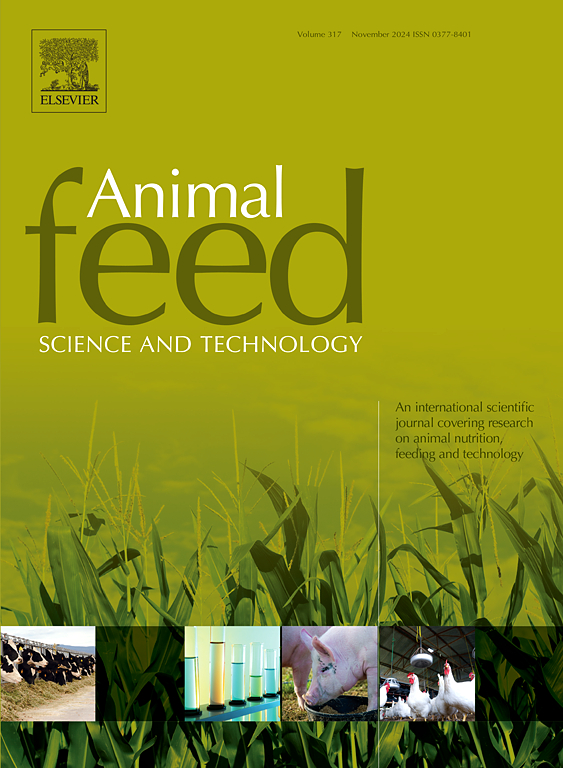用仙人掌替代三叶草:对奶山羊营养摄入、瘤胃发酵、血液代谢物、产奶量、饲粮成分和脂肪酸分布的影响
IF 2.5
2区 农林科学
Q1 AGRICULTURE, DAIRY & ANIMAL SCIENCE
引用次数: 0
摘要
在牲畜日粮中添加替代饲料可以提高产品的产量和质量,尤其是牛奶。本实验旨在研究在奶山羊日粮中以仙人掌科植物(CC)(Opuntia ficus-indica)代替苜蓿(BC)(Trifolium alexandrinum L.)对营养摄入量、瘤胃发酵、血液代谢物、牛奶产量、成分和脂肪酸组成的影响,添加水平为 0、150 和 300 克/千克(以干物质(DM)计)。21 只怀孕的大马士革山羊(体重为 56.6 ± 0.55 千克)在预产期前 30 天被随机分配到三个实验组,并在泌乳期产后持续 90 天。结果表明,随着日粮中CC比例的增加,非纤维碳水化合物的摄入量呈线性增加(P <0.01),而中性洗涤纤维和酸性洗涤纤维的摄入量呈线性下降(P <0.05)。瘤胃中的总挥发性脂肪酸水平以及乙酸盐(P = 0.022)和丁酸盐(P = 0.002)均呈线性增长(P = 0.004),而瘤胃pH值(P = 0.048)和氨氮浓度(P = 0.001)则随着CC比例的增加呈线性下降。此外,甘油三酯(P = 0.050)和胆固醇(P = 0.025)呈线性增加,而血液尿素水平则随着 CC 比例的增加呈线性下降(P < 0.01)和二次下降(P = 0.015)。牛奶产量(P = 0.016)、脂肪校正牛奶产量(P = 0.005)、脂肪产量(P = 0.012)、蛋白质产量(P = 0.030)、乳糖产量(P = 0.011)、总固形物产量(P = 0.042)和乳脂浓度(P = 0.014)都随着CC比例的增加而线性增加。此外,儿童的最终体重(P = 0.026)和平均日增重(P = 0.037)随 CC 比例的增加而线性增加。牛奶中脂肪酸的浓度,包括C6:0 (P = 0.037)、C14:0 (P = 0.003)、C14:1n-5 (P = 0.001)、C16:1n-7 (P = 0.010)、C18:1n-9c (P = 0.046)、C18:3n-3 (P = 0.001)和C20:5n-3 (P = 0.013),随着CC含量的增加而线性增加。相反,C18:0(P = 0.010)、C20:4n-6(P = 0.044)、饱和脂肪酸(SFA)总含量(P = 0.012)、SFA/MUFA 比率(P = 0.021)和 n-6/n-3 比率(P = 0.009)呈线性下降,而随着 CC 含量的增加,牛奶中单不饱和脂肪酸(MUFA)(P = 0.038)、多不饱和脂肪酸(PUFA)(P = 0.013)和 n-3 (P = 0.001)的总含量呈线性增加。由此可以得出结论,使用 CC 饲草替代 BC 饲草,可增强瘤胃发酵,提高泌乳奶山羊的生产性能。此外,它还提高了所产牛奶的质量,尤其是其中的 PUFAs 和 omega-3 脂肪酸含量。本文章由计算机程序翻译,如有差异,请以英文原文为准。
Utilization of cactus cladodes as a replacement for berseem clover: Effect on nutrient intake, rumen fermentation, blood metabolites, and milk yield, composition and fatty acid profile in the diets of dairy goats
The inclusion of alternative fodder in livestock diets can improve the production and quality of products, particularly milk. This experiment aimed to investigate the effect of replacing berseem clover (BC) (Trifolium alexandrinum L.) with cactus cladodes (CC) (Opuntia ficus-indica) at inclusion levels of 0, 150, and 300 g/ kg on a dry matter (DM) basis in the diets of dairy goats on nutrient intake, rumen fermentation, blood metabolites, and milk yield, composition, and fatty acid profile. Twenty-one pregnant Damascus goats (56.6 ± 0.55 kg of body weight (BW)), were randomly allocated into three experimental groups 30 days before their expected kidding date and continued for 90 days after parturition during the lactation period. Results indicated that as the proportion of CC in the diet increased, there was a linear increase (P < 0.01) in non-fiber carbohydrates intake, whereas the intakes of neutral detergent fiber and acid detergent fiber decreased linearly (P < 0.05). Ruminal levels of total volatile fatty acids increased linearly (P = 0.004), along with acetate (P = 0.022) and butyrate (P = 0.002), whereas ruminal pH (P = 0.048) and ammonia-N concentration (P = 0.001) decreased linearly with a higher proportion of CC. Additionally, there was a linear increase in triglyceride (P = 0.050) and cholesterol (P = 0.025), while blood urea levels decreased linearly (P < 0.01) and quadratically (P = 0.015) with a higher proportion of CC. The yields of milk (P = 0.016), fat-corrected milk (P = 0.005), fat (P = 0.012), protein (P = 0.030), lactose (P = 0.011), total solids (P = 0.042), and milk fat concentration (P = 0.014) all increased linearly with higher proportions of CC. Furthermore, final BW (P = 0.026) and average daily gain (P = 0.037) of kids increased linearly with a higher proportion of CC. The concentrations of fatty acids in milk, including C6:0 (P = 0.037), C14:0 (P = 0.003), C14:1n-5 (P = 0.001), C16:1n-7 (P = 0.010), C18:1n-9c (P = 0.046), C18:3n-3 (P = 0.001), and C20:5n-3 (P = 0.013), increased linearly with higher CC levels. In contrast, concentration of C18:0 (P = 0.010), C20:4n-6 (P = 0.044), total content of saturated fatty acids (SFA) (P = 0.012), SFA/MUFA ratio (P = 0.021), and n-6/n-3 ratio (P = 0.009) decreased linearly, while the total content of monounsaturated fatty acids (MUFA) (P = 0.038), polyunsaturated fatty acids (PUFA) (P = 0.013), and n-3 (P = 0.001) increased linearly in milk as the levels of CC increased. It can be concluded that the use of CC forage as an alternative to BC forage, enhanced rumen fermentation, and improved the productive performance of lactating dairy goats. Moreover, it enhanced the quality of the milk produced, especially its content of PUFAs and omega-3 fatty acids.
求助全文
通过发布文献求助,成功后即可免费获取论文全文。
去求助
来源期刊

Animal Feed Science and Technology
农林科学-奶制品与动物科学
CiteScore
6.00
自引率
6.20%
发文量
266
审稿时长
3 months
期刊介绍:
Animal Feed Science and Technology is a unique journal publishing scientific papers of international interest focusing on animal feeds and their feeding.
Papers describing research on feed for ruminants and non-ruminants, including poultry, horses, companion animals and aquatic animals, are welcome.
The journal covers the following areas:
Nutritive value of feeds (e.g., assessment, improvement)
Methods of conserving and processing feeds that affect their nutritional value
Agronomic and climatic factors influencing the nutritive value of feeds
Utilization of feeds and the improvement of such
Metabolic, production, reproduction and health responses, as well as potential environmental impacts, of diet inputs and feed technologies (e.g., feeds, feed additives, feed components, mycotoxins)
Mathematical models relating directly to animal-feed interactions
Analytical and experimental methods for feed evaluation
Environmental impacts of feed technologies in animal production.
 求助内容:
求助内容: 应助结果提醒方式:
应助结果提醒方式:


